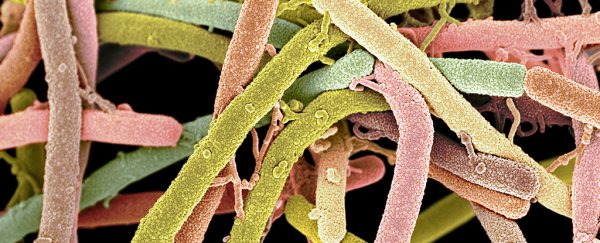Antibiotics have saved countless lives over the decades. Yet to the pathogens they kill, antibiotics are an ancient foe, one they are already adept at fighting.
It turns out the spread of antibiotic resistance might not be as constrained as we assumed, giving more species far easier access to antibiotic resistance than previous models would have us believe.
The findings come from a study carried out by bioinformatics researcher Jan Zrimec from Chalmers University of Technology in Sweden, which looked for signs of mobility among elements of DNA called plasmids.
If a genome was a cookbook, plasmids could be imagined as loose scraps of paper featuring prized recipes stolen from friends and relatives. Many contain instructions for making materials that can help bacteria survive under stressful conditions.
And for bacteria, a dose of antibiotics is about as stressful as it gets.
While we've been using them as a form of medicine for the better part of a hundred years, the truth is we've simply taken inspiration from a microbial arms race that could be nearly as old as life itself.
As different species of microbe concocted new ways to stymie the growth of their bacterial competitors through the ages, bacteria have come up with new ways to overcome them.
These defence measures are often preserved in the coding of a plasmid, allowing bacterial cells to easily share resistance through a process called conjugation. If that word evokes thoughts of encounters during prison visits, you need to stretch your imagination just a little further to picture it… between single-celled organisms.
In order for plasmids to be distributed widely between cells in an act of bacterial hanky-panky, they need to possess a region of genetic coding called an origin‐of‐transfer sequence, or oriT.
This sequence is what engages with an enzyme that slices the plasmid open for easy copying, and then seals it back up again. Without oriT, a plasmid's secret recipe is destined to remain in the possession of its owner.
In the past, it was believed each plasmid needed to possess both oriT and a code for the enzyme in order for it to be shared in acts of conjugation.
Today, it's clear the enzyme isn't necessarily specific to any particular oriT sequence, meaning if a bacterial cell contains numerous plasmids, some could benefit from the enzymes encoded by others.
If we want to come up with a catalogue of plasmids that can be shared – including those containing instructions for antibiotic resistance – we simply need to know how many contain an oriT sequence.
Unfortunately, finding and quantifying these sequences is a time-intensive and laborious job. So Zrimec has developed a far more efficient means of searching for oriT based on unique characteristics of the coding's physical properties.
He applied his findings to a database of more than 4,600 plasmids, calculating how common mobile plasmids were based on the prevalence of oriT.
It turns out we were probably way off the mark in how common this essential sequence happens to be, with Zrimec's results being eight times higher than those of previous estimates.
Taking other transference factors into account, it could mean there are twice as many mobile plasmids among bacteria than we imagined, with twice as many bacterial species in possession of them. And that's not all.
There was one other discovery Zrimec made that's a cause of concern.
"Plasmids belong to different mobility groups, or MOB groups, so they can't transfer between just any bacterial species," says Zrimec.
Yet his research now suggests half of the oriT sequences he found fit conjugation enzymes from a different MOB group altogether, suggesting the boundaries between bacterial species might be more permeable to plasmids than we thought as well.
All of this is troubling news in light of the race to develop new antibacterial treatments.
"These results could imply that there is a robust network for transferring plasmids between bacteria in humans, animals, plants, soil, aquatic environments and industries, to name a few," says Zrimec.
"Resistance genes occur naturally in many different bacteria in these ecosystems, and the hypothetical network could mean that genes from all of these environments can be transferred to bacteria that cause disease in humans."
It's an arms race we inserted ourselves into in order to save lives - never quite imagining how skilled bacteria would be in matching our firepower.
Technology like this will help us better understand what we're up against. And already, it's not looking pretty.
This research was published in Microbiology Open.
